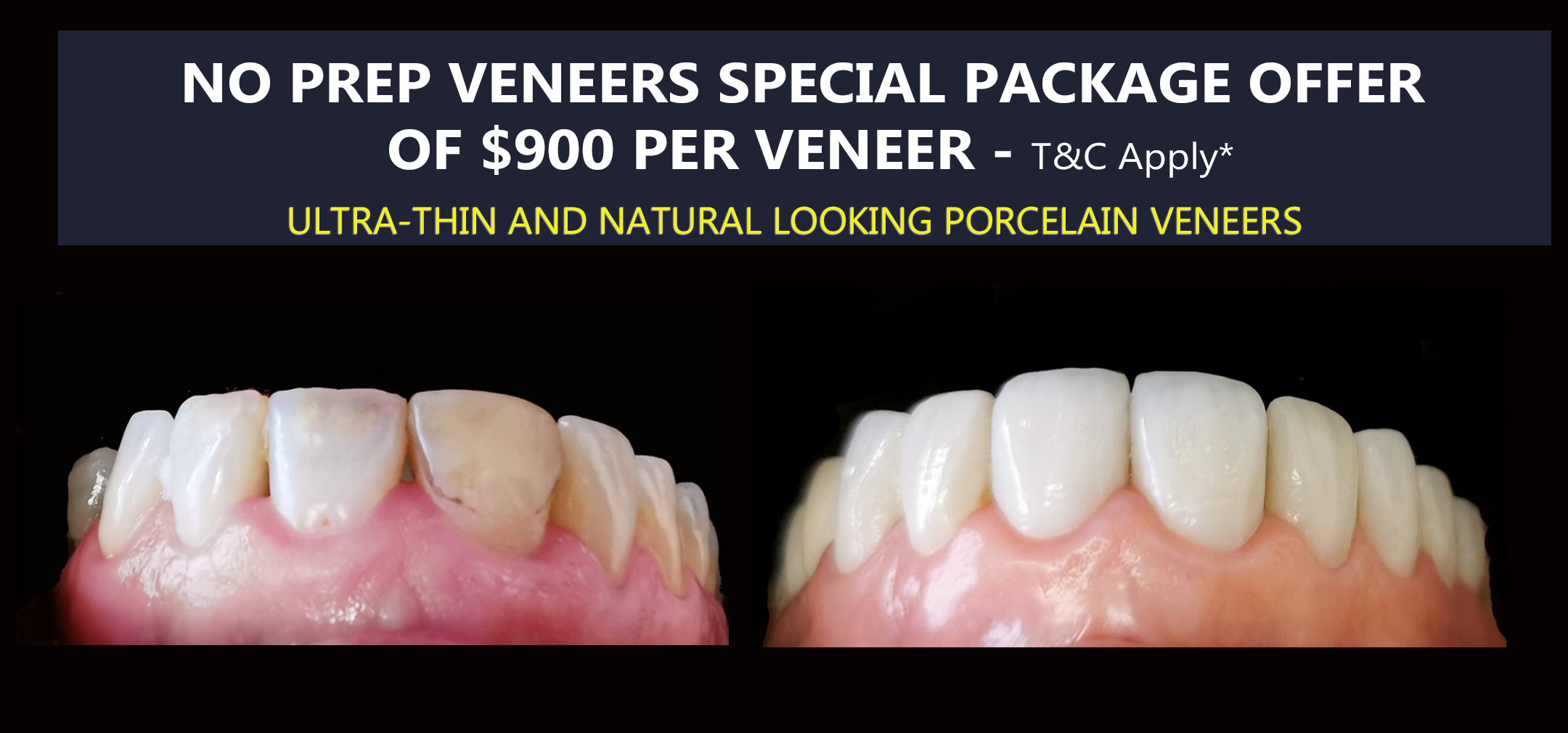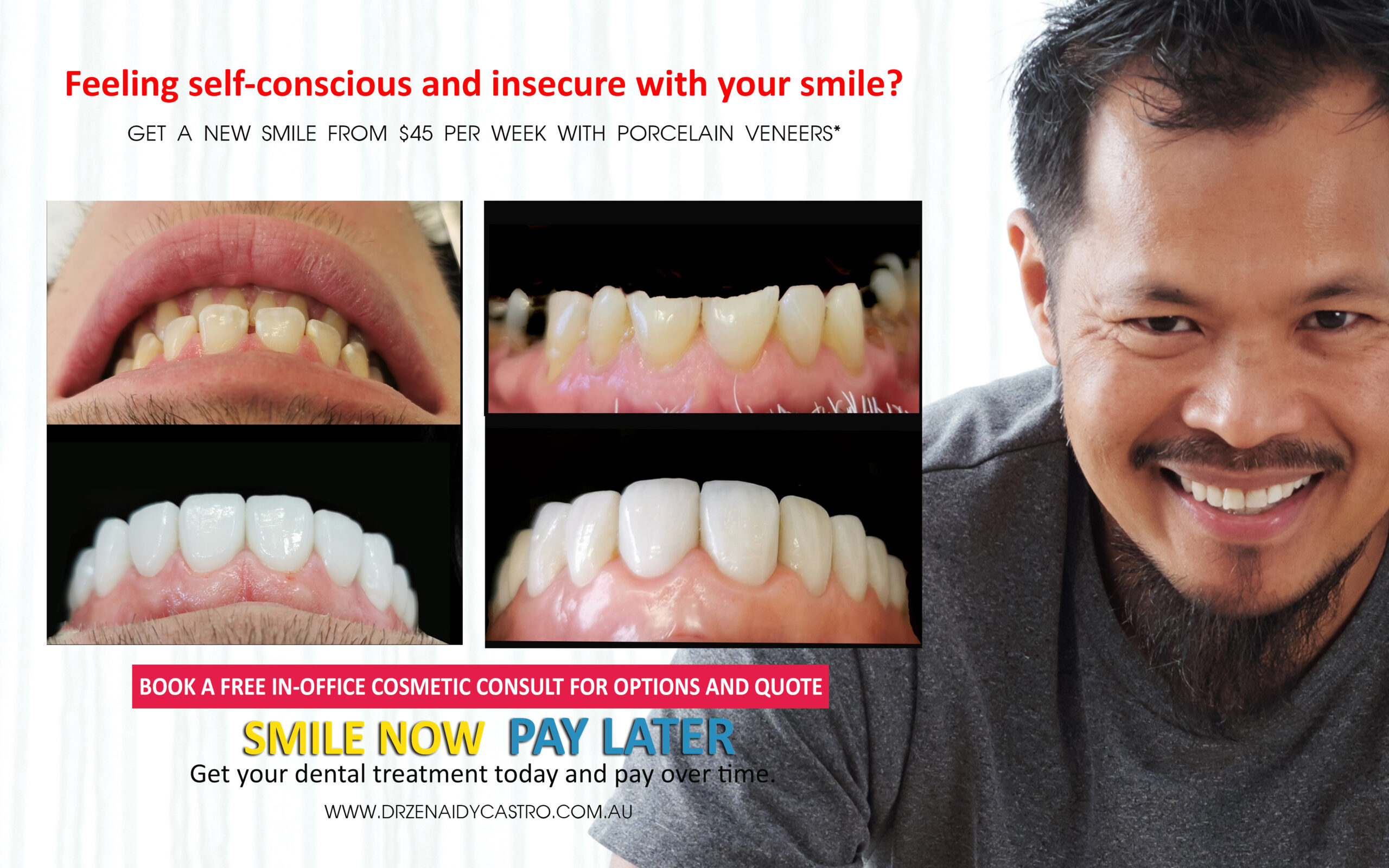
 Review the important terms and conditions that apply to this offer.
Review the important terms and conditions that apply to this offer.
✨ Tooth Bonding for Gaps and Spacing Between Your Front Teeth, quick and effective solution to close gaps between front teeth
✨ Minimally invasive procedure with no grinding required
✨ Single appointment treatment with immediate visible results
✨ Affordable compared to porcelain veneers and orthodontics
✨ Uses tooth-colored composite resin for a natural look
✨ Ideal for small gaps, chips, and minor cosmetic fixes
✨ Bonding is reversible and can be repaired easily if needed
✨ Not suitable for severe misalignment or bite issues
✨ Vogue Smiles offers a special packaged price of $900 per tooth (minimum 10 teeth) for no grinding or Prepless veneers
???? Call Vogue Smiles Melbourne and Noble Park today for a comprehensive general and smile makeover treatment — offering competitive pricing, bundled porcelain veneer specials, interest-free dental plans, and Superannuation access assistance.
REQUEST AN ONLINE PERSONALIZED QUOTE ➤
REQUEST FOR A FREE TELECONSULTATION ➤
Gaps between the front teeth—also known as diastema—may seem like a small cosmetic issue to some. But for those living with this condition, the emotional effects can be far more significant than many realize. While some individuals proudly embrace the unique look of spaced teeth, others feel deep discomfort and insecurity that affects their self-esteem, social interactions, and even their daily happiness.
The Emotional Impact of Gappy Teeth
Living with visible gaps in your front teeth can bring about a range of emotional challenges. For many, these spaces can feel like a spotlight on their smile, often drawing unwanted attention or leading to embarrassment. You may find yourself hesitant to smile in photos, suppressing laughter in social settings, or even covering your mouth during conversation. Over time, this constant self-consciousness can take a toll on your emotional well-being, making even joyful moments feel shadowed by insecurity.
Children and teenagers with gappy teeth may experience teasing or bullying, leading to long-lasting effects on self-image. Adults, too, may feel that gaps in their teeth make them appear less polished or professional, particularly in careers that involve public speaking or client interactions.
How a Beautiful Smile Transforms Lives
A beautiful smile is more than just aesthetics—it radiates warmth, approachability, and confidence. When you feel good about your teeth, you’re more likely to smile openly, speak confidently, and fully engage with the world around you. People often underestimate just how transformative it can be to close the gaps in their teeth—until they see the results.
When you fix your smile, you’re not just changing the way others see you; you’re changing the way you see yourself. You stand taller. You speak with ease. And most importantly, you reclaim your confidence.
Why Do You Have Teeth Gaps?
Understanding the Causes of Diastema
A gap between two teeth — especially the front teeth — is known as a diastema. While it can be part of your natural smile, for many people, it becomes a source of self-consciousness or concern. These spaces most commonly occur between the two upper front teeth, but can appear between any teeth in the mouth.
There are several possible causes of gappy teeth, ranging from natural growth patterns to habits and medical conditions. Here’s a breakdown of the most common reasons why you might have spaces between your teeth.
???? 1. Jaw-to-Tooth Size Mismatch
One of the leading causes of dental gaps is a disproportionate relationship between your jaw size and tooth size. If your jawbone is too large or your teeth are too small, it can create extra space between the teeth, especially the front ones.
???? 2. Missing or Undersized Teeth
When one or more teeth are naturally small or missing, the adjacent teeth may shift to try to “fill” the space. Unfortunately, this can create additional gaps elsewhere in your smile. These secondary gaps may become more noticeable over time.
???? 3. Oversized Labial Frenum
The labial frenum is the small piece of tissue that connects the inside of your upper lip to your gums. If this tissue is too large or extends too far down, it can physically block the natural closure of the space between your two front teeth, resulting in a prominent diastema.
???? 4. Thumb Sucking or Other Habits
Childhood habits such as thumb sucking or prolonged pacifier use can push the front teeth forward, resulting in gaps. Even if these habits stop with age, the resulting spacing often remains into adulthood.
???? 5. Tongue Thrusting When Swallowing
In a normal swallow, your tongue presses against the roof of your mouth. However, in some people, the tongue instead pushes forward against the front teeth. Over time, this can exert enough pressure to push the teeth apart, creating a noticeable space.
???? 6. Gum Disease and Bone Loss
Advanced gum disease (periodontitis) can affect the supporting structures of your teeth, including the jawbone. As the bone deteriorates, teeth can become loose and start to shift, leading to the development of new gaps or the worsening of existing ones.
Should You Be Concerned About Gappy Teeth?
Even if the gap doesn’t bother you aesthetically, it’s important to get your teeth checked by a dentist. In some cases, gaps may be a sign of underlying dental issues, such as gum disease or poor bite alignment.
By identifying the root cause, your dentist can recommend the most appropriate treatment — whether it’s cosmetic bonding, orthodontics, or porcelain veneers — to close the gap and protect your long-term oral health.
The Simple Power of Tooth Bonding for Gaps
If you’re looking for a non-invasive, fast, and affordable way to close the gaps in your front teeth, tooth bonding offers an excellent solution. This cosmetic treatment uses tooth-colored resin material applied directly to the teeth to reshape and fill in gaps, restoring a more uniform and appealing smile.
What makes bonding especially appealing is how quickly and comfortably it can be done—often in just one dental visit. There’s no need for braces or aligners. No enamel removal or extensive dental work. And yet, the improvement is immediate and significant.
Key Benefits of Tooth Bonding for Gappy Teeth
-
✅ Quick and pain-free solution completed in one visit
-
✅ Affordable compared to veneers or orthodontics
-
✅ No drilling or removal of natural tooth structure
-
✅ Ideal for small to moderate gaps between front teeth
-
✅ Boosts self-confidence and emotional well-being immediately

Close Front Teeth Gaps with Cosmetic Dental Bonding
(A Fast, Non-Invasive Fix for Gappy Smiles)
Have you ever wondered, “How can I correct the gap in my front teeth?” or asked yourself, “Is there an easier option than braces?” You’re not alone. Many people feel self-conscious about a visible space between their front teeth—clinically known as a diastema—especially when it affects their confidence or overall smile aesthetics.
Gaps between the front teeth are more common than you might think. Whether you’ve had this spacing since childhood or developed it later in life, it’s something many individuals choose to correct. While some embrace the uniqueness of a gappy smile, others seek cosmetic enhancement for improved confidence and appearance.
The good news? That gap doesn’t have to be permanent.
Dental Bonding to Fix Gappy Smiles: A Simple, Safe, and Beautiful Solution
One of the easiest and most cost-effective ways to close front teeth gaps is through cosmetic dental bonding. This treatment uses a tooth-colored composite resin material applied and sculpted onto the teeth to fill in the space, enhance shape, and restore balance to your smile.
Unlike traditional braces or clear aligners, dental bonding requires no tooth movement and offers instant results—often completed in just one visit. It’s an ideal solution for those seeking quick, non-invasive smile improvements.
What Is Cosmetic Dental Bonding?
Cosmetic dental bonding is a procedure in which a dentist applies a specially formulated composite resin to your natural tooth structure. The material is color-matched to blend seamlessly with your enamel and carefully sculpted to fill in the gap, reshape the tooth, and create a more harmonious appearance.
After shaping the resin, it’s hardened with a curing light and polished for a smooth, natural-looking finish. The result? A noticeably improved smile—without any drilling, braces, or downtime.
Composite Veneers to Close Spacing in Between Front Teeth
In cases where bonding alone may not offer sufficient coverage or strength, your dentist may recommend composite veneers. These are essentially custom-shaped resin shells applied to the front of the teeth, offering more durability and slightly more coverage than traditional bonding.
- Composite veneers are perfect for:
- Wider gaps between front teeth
- Discoloration or minor chips alongside spacing issues
- Patients looking for a reversible alternative to porcelain veneers
Whether you choose traditional bonding or composite veneers, both options deliver dramatic improvements in a short amount of time and with minimal discomfort.
Why Choose Dental Bonding to Fix Gappy Smiles?
✅ Fast and non-invasive — typically done in a single visit
✅ Painless — no needles, no drilling, and minimal preparation
✅ Cost-effective — significantly more affordable than porcelain veneers or braces
✅ Immediate aesthetic improvement — walk out with a confident, new smile
✅ Ideal for small to moderate gaps between front teeth
Is Dental Bonding Right for You?
If you’re self-conscious about a gap in your front teeth but don’t want to commit to braces or lengthy orthodontic treatments, then dental bonding to fix gappy smiles could be your perfect solution. It’s best suited for:
- Mild to moderate diastema
- Individuals with healthy gums and enamel
- Patients looking for quick, affordable cosmetic improvement
Key Benefits of Tooth Bonding for Gappy Teeth
✅ Quick and pain-free solution completed in one visit
✅ Affordable compared to veneers or orthodontics
✅ No drilling or removal of natural tooth structure
✅ Ideal for small to moderate gaps between front teeth
✅ Boosts self-confidence and emotional well-being immediately
Close Front Teeth Gaps with Cosmetic Dental Bonding Before and After




What Is Tooth Bonding with Composite Veneer?
A Complete Guide to the Procedure, Benefits, and Limitations
Tooth bonding, also known as dental bonding or cosmetic bonding, is a non-invasive aesthetic dental procedure designed to enhance the appearance of your smile. This technique involves the application of a tooth-coloured composite resin to the front surface of the teeth. Bonding is a versatile and cost-effective solution used to address a variety of dental concerns, including gaps between teeth (diastemas), chips, cracks, discoloration, and minor misalignments.
Unlike other cosmetic treatments such as porcelain veneers or crowns, dental bonding is a quick, comfortable, and minimally invasive option that can often be completed in a single appointment. The procedure is especially ideal for patients looking to improve the look of their smile without committing to more intensive or expensive treatments.
How Does Tooth Bonding with Composite Veneer Work?
The tooth bonding process is simple yet effective. The dentist applies a pliable resin material to the surface of the tooth and skillfully shapes it to achieve the desired look. The resin is then hardened using a special curing light. Once set, the bonded tooth is polished to match the surrounding natural teeth for a seamless finish.
Step-by-Step Process of Tooth Bonding with Composite Veneer:
- Consultation & Evaluation: Your dentist will examine your teeth to determine if bonding is suitable for your needs. They’ll discuss your goals and recommend the best shade of resin to match your natural enamel.
- Surface Preparation: The dentist lightly roughens the surface of the tooth and applies a conditioning liquid. This helps the resin adhere more securely.
- Application of Composite Resin: The tooth-coloured resin is applied in layers to the prepared surface. The dentist sculpts it carefully to the desired shape.
- Curing Process: A high-intensity UV light is used to harden (cure) the resin, locking it into place.
- Shaping & Polishing: Once the resin has cured, your dentist will trim, shape, and polish the bonded area to blend perfectly with your other teeth.
This entire process generally takes 30 to 60 minutes per tooth, and most bonding cases—especially gap closures or cosmetic corrections—can be completed in just one visit.
Close Front Teeth Gaps with Cosmetic Dental Bonding
One of the most popular applications of bonding is to Close Front Teeth Gaps with Cosmetic Dental Bonding. These spaces, called diastemas, especially between the two front teeth, can affect both confidence and appearance. Cosmetic dental bonding offers a fast, effective, and affordable method to fix this issue.
With Dental Bonding to Fix Gappy Smiles, composite resin is applied directly to the teeth, shaped to fill the space, and then hardened using UV light. This results in a more uniform, straight, and visually appealing smile without the need for braces or aligners.
Composite Veneers to Close Spacing in Between Front Teeth:
If you’re seeking a more enhanced and slightly more durable solution, Composite Veneers to Close Spacing in Between Front Teeth may be an alternative to traditional bonding. These offer additional coverage and strength while using the same composite material.
Advantages of Tooth Bonding with Composite Veneer
✔ Quick and Convenient: Most bonding procedures are completed in a single dental appointment—no need to wait for lab work or multiple visits.
✔ Non-Invasive: Minimal or no enamel removal is required, preserving your natural tooth structure.
✔ Affordable Cosmetic Solution: Tooth bonding is one of the most cost-effective aesthetic dental treatments, often ranging from $350 to $700 per tooth, depending on complexity.
✔ Natural Aesthetics: The tooth-coloured resin blends seamlessly with your natural teeth, creating a beautiful, undetectable result.
✔ Versatile Treatment: Bonding can address multiple concerns simultaneously, including chips, cracks, gaps, and discoloration.
✔ Painless Procedure: Typically, bonding requires no anesthesia unless a cavity is being filled.
✔ Reversible and Repairable: Since minimal preparation is needed, the procedure is reversible. Plus, bonded teeth can be easily touched up or repaired.
Disadvantages and Limitations of Tooth Bonding with Composite Veneer
While bonding offers numerous benefits, it also has some limitations when compared to longer-lasting cosmetic solutions such as porcelain veneers or crowns.
✘ Durability: Bonded resin is not as strong as porcelain. It may last 3–7 years with proper care but can chip or wear more quickly than veneers.
✘ Stain Resistance: Although bonding resists stains to some extent, it is not as stain-resistant as porcelain. Foods like coffee, tea, and red wine can cause discoloration over time.
✘ Not Ideal for High-Bite Pressure Areas: Bonding is better suited for front teeth, which experience less biting force. It is less appropriate for molars or areas where heavy chewing occurs.
✘ May Require Maintenance: Chips, cracks, or dullness may develop and necessitate repairs, polishing, or reapplication over time.
Tooth Bonding with Composite Veneer vs. Porcelain Veneers
| Feature |
Tooth Bonding |
Porcelain Veneers |
| Treatment Time |
1 Visit |
2–3 Visits |
| Durability |
3–7 Years |
10–20 Years |
| Cost Per Tooth |
$250–$600 |
$900–$2,000 |
| Stain Resistance |
Moderate |
High |
| Tooth Reduction |
Minimal or None |
Minor Enamel Removal (or None with Prepless) |
| Aesthetic Results |
Good |
Excellent |
| Reversibility |
Yes |
Sometimes (especially No-Prep) |
| Maintenance |
Occasional Touch-Ups |
Less Frequent Maintenance |
While veneers offer longer-lasting and more dramatic cosmetic improvements, Close Front Teeth Gaps with Cosmetic Dental Bonding is perfect for patients seeking affordable, immediate, and minimally invasive corrections—especially for spacing between front teeth.
Is Cosmetic Dental Bonding Right for You?
You may be an ideal candidate for Dental Bonding to Fix Gappy Smiles if:
- You have small gaps between your front teeth.
- You’re looking for a non-permanent, reversible option.
- You need a quick cosmetic fix before a special event.
- You prefer a cost-effective treatment.
- You have chipped, slightly misaligned, or discoloured teeth.
Bonding is not ideal for those needing extensive dental corrections or bite realignment. In such cases, orthodontics or veneers may be better options.
Caring for Bonded Teeth
To maintain the longevity and beauty of your bonded teeth:
- Brush twice daily and floss regularly.
- Avoid biting into hard objects (e.g., pens, ice, or fingernails).
- Minimise staining foods and beverages.
- Visit your dentist regularly for professional cleanings and inspections.
With proper care, bonding can remain beautiful and functional for years.
Book a Smile Assessment at Vogue Smiles Melbourne
If you’re looking to Close Front Teeth Gaps with Cosmetic Dental Bonding, we’re here to help. At Vogue Smiles Melbourne, Dr. Zenaidy Castro offers expert aesthetic dental care using high-quality composite materials and artistry that blends perfectly with your natural smile.
✨ We also offer Composite Veneers to Close Spacing in Between Front Teeth for patients wanting slightly more durability and coverage.
???? Contact us today to schedule your consultation and rediscover the power of a confident, gap-free smile.
Frequently Asked Questions About Tooth Bonding
Is Tooth Bonding Permanent?
No, tooth bonding is not a permanent solution. However, it offers excellent longevity considering its affordability and simplicity. On average, tooth bonding can last between 3 to 8 years depending on personal habits like oral hygiene, diet, and habits such as nail biting or using your teeth to open objects. With proper care, bonding can provide many years of aesthetic satisfaction before requiring touch-up or replacement.
Can Tooth Bonding Be Whitened?
Unfortunately, tooth bonding material cannot be whitened with conventional teeth whitening treatments. Unlike natural enamel, composite resin does not respond to whitening agents. If the bonded area becomes stained or no longer matches the color of surrounding teeth, your dentist can remove and replace the resin with a fresh layer that better matches your natural or whitened teeth. For this reason, it’s advisable to undergo any whitening treatments before having tooth bonding done.
Is Tooth Bonding a Good Idea?
Yes, tooth bonding is a great idea for patients seeking an affordable, fast, and minimally invasive solution for various cosmetic dental issues. It’s particularly ideal for:
-
Fixing minor chips and cracks
-
Closing small to moderate front teeth gaps
-
Improving discolouration
-
Correcting uneven edges or slightly misaligned teeth
Patients who don’t want to commit to the higher cost or irreversible nature of veneers often find tooth bonding to be the perfect starting point on their smile transformation journey.
Close Front Teeth Gaps with Cosmetic Dental Bonding Before and After

Other Treatment Options for Teeth Gaps
If you’re looking to close gaps between your teeth, there are several effective treatment options available. The best choice depends on the size of the gap, the condition of your teeth, your budget, and your long-term dental goals. Here’s a detailed look at the most popular solutions:
Porcelain Veneers
Porcelain veneers are a highly popular and effective cosmetic option for closing gaps between front teeth. A veneer is a thin shell of porcelain custom-crafted in a dental laboratory to match the natural shape, size, and colour of your teeth. Like a delicate mask, the veneer is bonded securely to the front surface of your tooth, concealing gaps, chips, discoloration, and other imperfections.
Once bonded, porcelain veneers become very strong and durable, offering a long-lasting aesthetic enhancement that can dramatically improve your smile.
Advantages of Porcelain Veneers:
-
Natural Appearance: Porcelain mimics the translucency and opalescence of natural tooth enamel, blending seamlessly with your existing teeth.
-
Durability: Although porcelain can chip if subjected to trauma, well-made veneers typically last 10 to 15 years or longer with proper care.
-
Stain Resistance: Porcelain resists staining better than composite resin, maintaining its bright, glossy finish over time.
-
Comprehensive Smile Makeover: Veneers allow for significant changes in the size, shape, colour, and alignment of your teeth, making them ideal for complete smile transformations.
-
Superior Strength: Compared to composite veneers or bonding, porcelain offers much greater strength once bonded to your tooth, ensuring longevity and resilience.
Disadvantages of Porcelain Veneers:
-
Multiple Visits Required: Porcelain veneers must be fabricated in a lab, so the process involves at least two dental visits — one for tooth preparation and impressions, and another for fitting and bonding.
-
Higher Cost: Veneers are more expensive than composite bonding due to the material cost and the technical expertise required to craft and fit them perfectly.
-
Irreversible Procedure: Some enamel must be removed to fit veneers, which means the process is permanent and cannot be reversed.
Which Cosmetic Procedure Offers the Most Natural Aesthetic Result?
When deciding between Tooth Bonding and Porcelain Veneers for closing gaps, many dentists agree that porcelain veneers deliver the most natural, tooth-like aesthetic.
-
Porcelain possesses a translucent quality very similar to natural enamel. Its smooth glaze reflects light beautifully, offering a shine and texture that closely mimics real teeth.
-
Porcelain veneers are also far more resistant to staining and chipping, thanks to their durable material and protective finish.
On the other hand:
-
Composite bonding (or composite veneers) is more porous, making it susceptible to staining from foods and drinks such as coffee, tea, and red wine.
-
Composite resin requires regular polishing to maintain its appearance but still doesn’t quite match the smoothness and translucency of porcelain.
-
Bonding is best for smaller, less permanent fixes and is more affordable, but the aesthetic and longevity trade-offs should be considered.
Aesthetic Comparison: Tooth Bonding vs Porcelain Veneers
| Feature |
Tooth Bonding (Composite) |
Porcelain Veneers |
| Natural Look |
Good, but less translucent and glossy |
Excellent, closely mimics natural enamel |
| Durability |
Lasts 3–8 years; prone to chipping |
Lasts 10–15 years; stronger and more chip-resistant |
| Stain Resistance |
Moderate; can stain with time |
High; resists staining well |
| Procedure Time |
Usually one visit |
Requires two or more visits |
| Cost |
More affordable |
More expensive |
| Tooth Preparation |
Minimal or none |
Usually requires some enamel removal |
| Maintenance |
May need repairs or touch-ups over time |
Less frequent maintenance |
If you want a natural, durable, and long-lasting solution for closing gaps, porcelain veneers are the gold standard. However, for fast, affordable, and minimally invasive cosmetic fixes, tooth bonding remains a popular choice.








Other Cosmetic Issues That Tooth Bonding Can Address
Beyond closing gaps, tooth bonding is a versatile cosmetic procedure that can solve many aesthetic challenges:
✔ Chipped Teeth: Minor chips can be reshaped and blended seamlessly with the natural tooth using bonding resin.
✔ Discoloration: Composite can mask stubborn stains that don’t respond to whitening.
✔ Misshapen Teeth: Teeth that are too short, pointy, or irregular in shape can be sculpted for a more harmonious look.
✔ Filling Spaces Between Teeth: Aside from major gaps, bonding is great for subtle spacing corrections to bring symmetry to the smile.
✔ Tooth Fillings in Visible Areas: Composite bonding is used for filling cavities in front teeth, offering an aesthetically superior alternative to metal fillings.
???? See our stunning before-and-after photos below for examples of how dental bonding transformed real patients’ smiles.









Orthodontic Treatment
For more severe or complex gaps between teeth, orthodontic treatment is often the most effective and permanent solution. Simply pushing the two front teeth together without considering the rest of the dental arch can create new gaps elsewhere. That’s why orthodontists use braces or invisible aligners to carefully adjust the position of multiple teeth and the overall alignment of your dental arches.
Options:
-
Traditional Braces: Fixed metal or ceramic braces apply continuous pressure to shift teeth gradually into ideal positions. They are highly effective but can be more visible and require more maintenance.
-
Invisible Aligners: Clear, removable aligners (like Invisalign) are a popular alternative to braces. They are comfortable, discreet, and easy to clean, making them an attractive option for closing gaps without the aesthetic concerns of metal braces.
Benefits of Orthodontic Treatment:
-
Long-Lasting Results: Orthodontics can correct not only gaps but also bite issues, misalignment, and crooked teeth, providing comprehensive oral health benefits.
-
Healthier Smile: Aligners promote better oral hygiene as they are removable, reducing plaque build-up compared to fixed braces.
-
Natural Tooth Preservation: Unlike veneers, orthodontics does not require removal of tooth enamel.
Considerations:
-
Orthodontic treatment usually takes longer—several months to years—depending on the complexity of the case.
-
It is typically more expensive upfront but offers permanent, natural results.
-
Tooth bonding is not a substitute for orthodontic treatment. It is mainly suitable for small gaps and cosmetic enhancements, not for correcting misaligned bites or crowded teeth.

Begin Your Smile Transformation Today
Whether you’re preparing for a milestone event, stepping back into the professional world, or finally ready to smile with pride—there’s no better time to start your transformation. Let Vogue Smiles Melbourne help you reclaim the joy, confidence, and freedom that come with a radiant, worry-free smile.
Your dream smile is closer than you think. Trust your transformation to a dentist with over 3 decades of passion to Cosmetic Dentistry
Book Your Smile Makeover Consultation
???? Call (03) 9629 7664 | 0413 014 122
REQUEST AN ONLINE PERSONALIZED QUOTE ➤
REQUEST FOR A FREE TELECONSULTATION ➤



Disclaimer:
The information on this website is for information purposes only. Is not a substitute for a proper professional care and advice. Each patient’s outcomes, risks, potential complications, and recovery differ. Any dental procedure, minor or major, carries risks, some minor and some serious. Before and after images seen on our Social Media and website pages are our actual patient and have been published/posted with our patients’ permission. All of our patients photos are subject to Copyrights protection. We are strong believers in responsible aesthetics. Every cosmetic, medical, or dental procedure comes with its own set of risks and benefits. Cosmetic Dentistry results will vary from patient to patient. Call our office and book for an actual in-office consultation for us to assess if you are a good candidate for a particular treatment. All of our Specials and packages posted on this site are subject to terms, conditions and availability. The exact fee for a particular cosmetic procedure will be determined after a preliminary assessment distinguishing your unique personal needs and the type of work needed. The prices mentioned on any of our website as well as any mentioned payment plan by a third party source, are just a guide and is subject to change. Call the third party financing providers or visit their website for more info. Please call the office on 9629-7664 for further queries or clarification.




